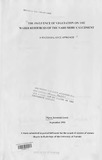The influence of vegetation on the water resources of the Naro Moru catchment A Water Balance Approach

View/
Date
1995-09Author
Njeru, Jeremiah Lewis
Type
ThesisLanguage
enMetadata
Show full item recordAbstract
On the slope West and North of Mt. Kenya, population increase has lead to rapid
land use change and increased demand for water resources. In this area, Water
resources are limited and fragile. To achieve socio economic development,
advisory and utilisation tools are required to guide sustainable development of
water resources. As a contribution to this challenge, the influence of vegetation on
the water resources of the Naro Moru river was investigated through a water
balance approach.
The Naro Moru river, an important water source within the upper Ewaso Ngiro
basin, extends from the peak region of Mt. Kenya (5200 meters above sea level)
and moves out Westwards traversing five ecological zones to the confluence with
the Ewaso Ng'iro at 1800 meters above sea level.
The study covered the Alpine, Moorland, Forest and Foot zones of the catchment.
Climatic and soil water measurement were made during the study period.
Measurement of rainfall, windspeed, temperature, humidity and sunshine hours
were made on daily basis and evapotranspiration calculated from the climatic data
using the Penman method. The climatic water balance was hence calculated as the
difference between rainfall and evapotranspiration.
Soil water content was determined gravimetically on monthly intervals in the Alpine
and Moorland zones and using a neutron probe on weekly intervals in Forest and
Footzone. From the soil water measurements, the available soil water for different
vegetation systems and its change with time and space was evaluated.
The influence of vegetation, on the water resources was hence investigated by
evaluating the climatic water balance, the available soil water and the vegetation
water balance.
The climatic water balance of the four zones was found to be significantly different
in the five zones. In the 1stwet and dry periods, the climatic water demand was met
only in the Alpine and Moorland zones. In the 2nd wet period, the climatic water
demand was met in all the zones except in the Footzone.
The available soil water for different vegetation, ecological and slope conditions
was found to be significantly different. The Potato and grass vegetation showed
higher and less varied soil water compared to the natural Forest vegetation and
cypress plantation vegetation. The Moorland zone showed higher available soil
water content compared to the Alpine zone. The lower Forest showed higher
available soil water compared to the upper Forest and Footzone.
From the vegetation water balance analysis, the vegetation water requirement was
higher for the natural Forest and Cypress plantation compared to the Potato crop
and Grass vegetation. In the Alpine and Moorland zone, the latter vegetation
showed high water use. Weather conditions wet and dry period) were found to be
important for the differences observed in the vegetation water balance. Vegetation
water requirement was generally higher than water use in the dry period and lower
than water use in the wet periods.
It is recommended that when planning for water resources, weather, ecological and
vegetation differences should be considered. Further, future research activities
should aim at developing practical water balance models which could be transfered
to other similar areas. This could be achieved through field measurements of soil
water, deep percolation and surface runoff.
Citation
Masters thesis University of Nairobi 1995Publisher
University of Nairobi Department of Geography and Environmental Studies
Description
A thesis submitted in partial fulfilment for the award of masters of science degree in Hydrology of the University of Nairobi
